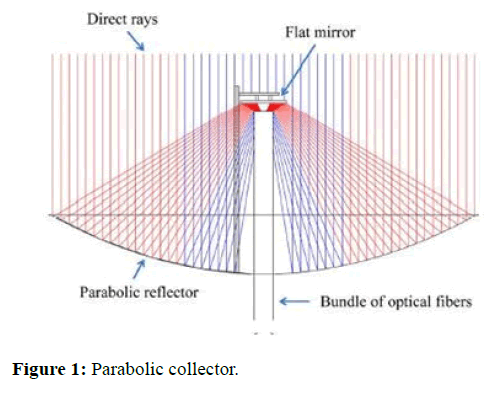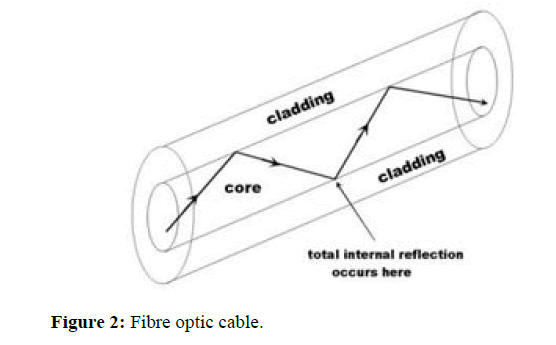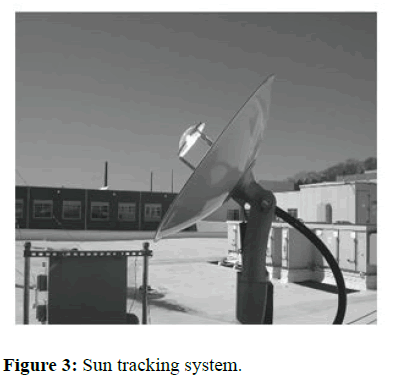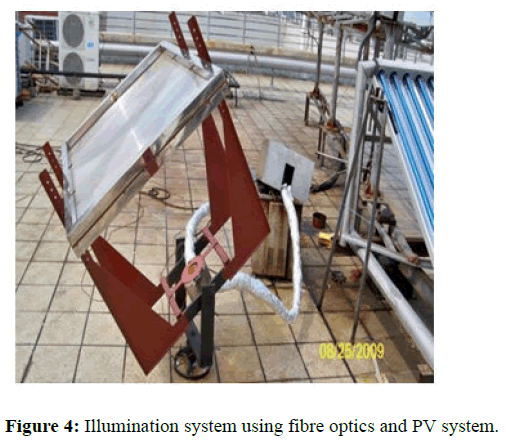Mini Review, J Electr Eng Electron Technol Vol: 12 Issue: 3
Solar System Using Fibre Optics and PV Cells
Ekta Mishra1*, Prashant Patel2 and Hemlata Joshi3
Department of Electrical Engineering, Dr. D. Y. Patil Institute of Technology, Pune, India
*Corresponding Author: Ekta Mishra
Department of Electrical Engineering,
Dr. D. Y. Patil Institute of Technology,
Pune,
India;
E-mail:ektamishra0707@gmail.com
Received date: 11 May, 2020, Manuscript No. JEEET-23-10608;
Editor assigned date: 14 May, 2020, PreQC No. JEEET-23-10608 (PQ);
Reviewed date: 28 May, 2020, QC No. JEEET-23-10608;
Revised date: 19 May, 2023, Manuscript No. JEEET-23-10608 (R);
Published date: 16 June, 2023, DOI: 10.4172/2325-9838.1000946
Citation: Mishra E, Patel P, Joshi H (2023) Solar System Using Fibre Optics and PV Cells. J Electr Eng Electron Technol 12:3.
Abstract
Sunlight is abundantly available throughout the day. The solar radiation is the most economical source for illuminating indoor spaces effectively. Hence, a system comprising of a solar collector with fibre optic cable for light transportation with combination of a solar PV system for storage of sunlight in the form of electricity is suggested. By combining the fibre optic system with the solar PV system, the illumination is possible all time of the day reducing the dependency on the grid.
Keywords: Hybrid system, Solar, Fibre optics, Transportation
Introduction
Natural light plays a vital role in every individuals life i.e., the star radiated energy reaching the earth’s surface during the day time. At the beginning of the human era, people completely relied upon daylight and fire as a source of illumination in their livelihood [1].
Over the last few decades, with ever increasing development daylighting is replaced with electrically produced light. The dramatic improvements in the efficiency, size and quality of electric light source varied the standard design practices of artificial lighting system. In order to obtain high quality electric lighting, overuse of conventional fuels lead to degradation of earth’s natural resources. Also, obtaining the energy is not free of cost. Hence, the best way is to divert ourselves to the usage of complete renewable sources which is beneficial in terms of cost, environment, maintenance etc. The hybrid solar system is a method which inclines towards the renewable system. The hybrid solar system comprises of a day lighting system using fibre optics in addition with solar panels situated at the roof top of the workspace [2].
During the dawn, the day lighting system using fibre optics dominates and guides the irradiated sunlight into workspace for proper diffusion. At the dusk, the energy stored in the batteries by absorbing solar radiated light into the PV cells plays the role of illuminating the workspace [3].
Literature Review
Fibre optic illuminance system can be classified into two parts i.e., passive day lighting system and active day lighting system. Passive day lighting system usually consists of sun collector, tracking system and luminaries to distribute the system sunlight. In active day lighting system, the main components are solar PV system in-addition to passive day lighting system. Hence, the major equipment’s are:
Solar collector
Solar collector is the basic need for the collection of sunlight which holds the base of hybrid day lighting system. The functionality of a solar collector is its collection efficiency, the consistency of gathering maximum amount of sunlight and the duration over which the system can be maintained. The shape of the collector decides the concentration level of the collected sunlight. A parabolic collector is a solar thermal collector that is straight in one dimension and curved as a parabola in the other two lines with a polished metal mirror [4].
The sunlight which enters the mirror parallel to the plane of symmetry is focused along the focal line, where objects which need to be intended are heated. Design of parabolic trough is shown in Figure 1.
Typhoid is among the most endemic diseases and thus of major public health concern in tropical developing counties like Tanzania. Therefore the information about its spread and transmission in a given area become stimulant of awareness and prevention among the people. The government and other authorities use social media and related means to circulate the information on eruption of typhoid [5]. In this paper, therefore, we present the mathematical model which explain the effect of information on dynamics of typhoid fever. Furthermore, we introduce essential parameters that can lead to the reduction of the spread of diseases based on the information received by susceptible people [6].
Fibre optic cables
Optical fibre comprises of a dielectric material i.e., glass, quartz and so on which directs the light. The optical fibre comprises of a centre, cladding and an outer defensive sheet. Regularly another layer called as the buffer, which shields the fibre from harm encompasses the jacket [7].
The light goes inside the centre and the cladding whose refractive index is less and gives interior reflection at the limit of the core. The shine of an optical fibre is reliant on numerous elements, for example, the measure of approaching light, shading, refraction edge, seeing edge and transmission. The transmission is completely based upon refraction of the material (Figure 2) [8].
Luminaries
Keeping in mind the end goal to give a decent blend of light from the two sources it is critical that they both have similar qualities, for example, light shading and spatial dispersion as indicated by hybrid lighting system. It is likewise vital that the control framework ought to have intensity fluctuations of regular light in-accordance with the atmosphere. There are two different techniques that allow light to incorporating sunlight to get diffuse in the expected area. To use cylindrical diffusing rods placed adjacent to the ordinary light tubes in the luminaries. Light is emitted from the end of this rod. The part of the rod facing the base is clear and transmits light while the upper half diffuses and scatters the light downwards. It is based on dispersing elements in the luminaries acrylic lens diffuser. The light dispersing elements consists of micro-optics structures to disperse light coming from the fibre end mounted above pointing downwards [9].
Hybrid solar luminaries are most suitable for human eye comfort as there is proper blending of natural as well as artificial light. For proper distribution, a suitable distributor is needed. In case of hybrid solar illumination the main objective is to keep the natural effect of sunlight in indoor space. The conventional distributors hence cannot be used for distribution. Linear fresnel lens are most suitable light distributors. In this mechanism, a point source is diverged to a wide area without changing natural effect of light. But the use of glass for the production of these lens is an expensive process. To cope up with this problem, the material from which it should be made is plastic. Plastic moulding is a cheap process and if made in mass, it is cost effective [10].
Sun tracking system
The movements to align the optical collectors in the sun direction were performed in two directions by using an equatorial configuration: The directions being on the temporal axis and on the declination axis.
Single axis sun tracking system: In this system, the movement of the sun tracker is in a single plane. Hence, the axis of the sun cannot be traced.
Dual axis sun tracking system: In this system, the movement of the sun tracker takes place in the plane i.e., horizontal as well as vertical. Hence, the axis of the sun can be tracked at every interval of the day irrespective of any season (Figure 3) [11].
Discussion
The system shown in Figure 4 comprises of a solar and lighting module. The lighting module consists of a suitable solar collector, secondary mirror (convex) and optical fibre. It also an efficient daylighting system should be able to direct maximum amount of sun irradiance with the help of a solar concentrator in-order to illuminate a specific area [12].
The main idea to design the system is to fetch high intensity sunlight with the help of suitable collector. The incident rays will get reflected from the primary collector to the secondary mirror and further will converge at a single point as per the position of the focal point on the dish. Obtained irradiance is then allowed to pass through a filter i.e., cold mirror. The purpose of introducing a filter is to reject the UV radiations and allow the visible rays to pass through the optical fibre. The optical fibre guides the sunlight into the chosen workspace in order to illuminate the area. At the end, a fresnel lens is used as a diffuser which will distribute the light equally [13].
During the day time, solar PV modules play their simultaneous role. The solar module consists of a PV panel, battery, a charge regulator and an inverter. The photovoltaic effect is the basic principle process by which a PV cell converts sunlight into electricity. When the shines on a PV cell, it may be reflected, absorbed or allowed to pass right through it. The absorbed is responsible to generate the electricity. The light stored by the panel consists of photons [14]. At the dusk, the solar panel converts these photons into electrons of direct current i.e., DC electricity. The electrons flow out of the solar panel into an inverter and other electrical safety devices. The inverter converts that DC power into AC power. When the intensity of the sunlight goes on decreasing, the electricity from the solar panel can be obtained so as to luminate the workspace [15].
Conclusion
Study of solar illumination have been carried out and it is observed that the use of parabolic dish for concentration of light energy is most suitable and less expensive to give maximum intensity into the workspace, also the implementation of the system is easy. Use of fibre optic cable for light transmission is most effective solution to transfer the light through various different paths. The point source of the light is maintained only by the use fibre optic cable. The Fresnel lens is more suitable to distribute light rather than reflecting surfaces because the area of distribution is more keeping the natural effect of the sunlight constant. The addition of PV module with the fibre optic system fledged the attribute towards renewable system. The system discussed above is completely based on natural light for all day illumination and does not depend on the grid. This reduces the regular maintenance, expensive cost and electricity failure from the substation. Also it is environment friendly and does not lead to degradation of natural resources by any means.
References
- Dhanalakshmi S, Chakravartula V, Narayanamoorthi R, Kumar R, Dooly G, et al. (2022) Thermal management of solar photovoltaic panels using a fibre Bragg grating sensor-based temperature monitoring. Case Stud Ther Eng 31: 101834.
- Li G, Feng F, Wang F, Wei B (2022) Temperature field measurement of photovoltaic module based on fiber Bragg grating sensor array. Materials 15: 5324.
[Crossref] [Google Scholar] [PubMed]
- Tamchek N, Michael AP, Sandoghchi SR, Hassan MR, Dambul KD, et al. (2011) Design, characterization and implementation of a fiber Bragg grating temperature sensor for application in solar power electronic inverters. Appl Solar Ener 47: 184-188.
- Li G, Wang F, Feng F, Wei B (2022) Hot spot detection of photovoltaic module based on distributed fiber Bragg grating sensor. Sensors 22: 4951.
[Crossref] [Google Scholar] [PubMed]
- Dhanalakshmi S, Nandini P, Rakshit S, Rawat P, Narayanamoorthi R, et al. (2022) Fiber Bragg grating sensor-based temperature monitoring of solar photovoltaic panels using machine learning algorithms. Opt Fiber Technol 69: 102831.
- Werneck MM, Allil RC, Ribeiro BA (2013) Calibration and operation of a fibre Bragg grating temperature sensing system in a grid‐connected hydrogenerator. IET Sci Meas Technol 7: 59-68.
- Daud S, Jalil MA, Najmee S, Saktioto S, Ali J, et al. (2011) Development of FBG sensing system for outdoor temperature environment. Proc Eng 8: 386-392.
- Kadhim SA, Taha SA, Resen DA (2015) Temperature sensor based on Fiber Bragg Grating (FBG), implementation, evaluation and spectral characterization study. Intern J Innov Res Sci Eng Technol 4: 8038-8043.
- Mishra V, Lohar M, Amphawan A (2016) Improvement in temperature sensitivity of FBG by coating of different materials. Optik 127: 825-828.
- Samiappan D, Kesarikiran AV, Chakravartula V, Kumari CU, Shubham K, et al. (2020) Enhancing sensitivity of fiber Bragg grating-based temperature sensors through teflon coating. Wireless Pers Comm 110: 593-604.
- Daud S, Abd Aziz MS, Chaudhary KT, Bahadoran M, Ali J (2016) Sensitivity measurement of fibre Bragg grating sensor. J Tech 78.
- Mohammed A, Hu B, Hu Z, Djurovic S, Ran L, et al. (2020) Distributed thermal monitoring of wind turbine power electronic modules using FBG sensing technology. IEEE Sens J 20: 9886-9894.
- Reddy PS, Sai Prasad RL, Srimannarayana K, Sai Shankar M, Sen Gupta D (2010) A novel method for high temperature measurements using fiber Bragg grating sensor. Opt Appl 40: 685-692.
- Liu Y, Zhang J (2016) Model study of the influence of ambient temperature and installation types on surface temperature measurement by using a fiber Bragg grating sensor. Sensors 16: 975.
[Crossref] [Google Scholar] [PubMed]
- Leal-Junior A, Casas J, Marques C, Pontes MJ, Frizera A (2018) Application of additive layer manufacturing technique on the development of high sensitive fiber Bragg grating temperature sensors. Sensors 18: 4120.
[Crossref] [Google Scholar] [PubMed]
 Spanish
Spanish  Chinese
Chinese  Russian
Russian  German
German  French
French  Japanese
Japanese  Portuguese
Portuguese  Hindi
Hindi 




